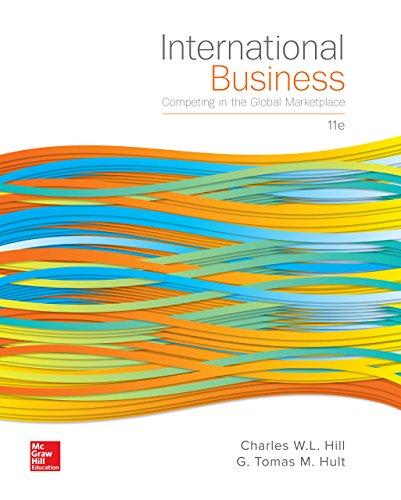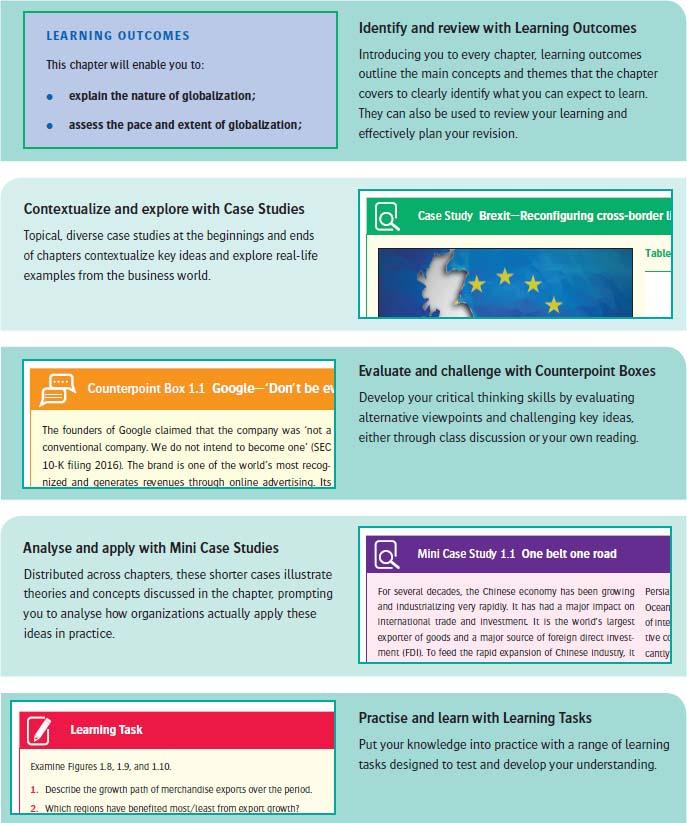Detailedcontents
Listoffigures
Listoftables
Listofcases
Guidetothebook
How tousethis book
How tousetheonlineresources
Abouttheauthors
Contributors
Mapoftheworld
PARTONE GlobalContext
1
Globalization
LeslieHamilton
TheProcess ofGlobalization
Globalizationis NotGlobal(Yet)
TheIndicators ofGlobalization
FinancialFlows
Migration
Globalizationis All-pervasive
TheDrivers ofGlobalization
Barriers toGlobalization
CulturalandGeographicalDistance
TheBenefits andCosts ofGlobalizationfor Business
2
TheGlobalEconomy
StevenGregory
Introduction
MeasuringtheSizeoftheGlobalEconomy
GDP as anIndicator oftheStandardofLiving
Economic Growth
TheChangingWorldEconomy
InternationalTrade TradeIntervention
ExchangeRates
AnalysingGlobalIndustries
LeslieHamilton
Introduction
TheMarketandtheIndustry
MarketStructures
MarketPower
MeasuringMarketConcentration
AnalysingIndustries—A Framework
TheGlobalBusiness Environment
LeslieHamilton
Introduction
TheExternalEnvironment
Opportunities andThreats
ScanningtheEnvironment
TheMacro-environment
PoliticalandLegalEnvironment
Economic andFinancialEnvironment
Socio-culturalEnvironment
TechnologicalEnvironment
TheEcologicalEnvironment
CorporateSocialResponsibility
PhilipWebster
Introduction
Debates aboutCSR
TheMoralCasefor CSR
TheBusiness Case
GlobalCSR
WhoseStandards?
TheTenPrinciples
Corruption
ChildLabour
SustainableDevelopmentGoals
TheSustainableDevelopmentGoals andBusiness
AssessingCountry Attractiveness
PhilipWebster
Introduction
TheInternationalizationProcess
TheReasons for FDI
ScreeningandEvaluatingForeignMarkets
CollectingData
InternationalDataProblems
TheProcess ofAssessingCountry Attractiveness
PARTTWO GlobalIssues
TheSocio-culturalFramework
LeslieHamilton
Introduction
Culture
TheSocialEnvironment
TheTechnologicalFramework
JohnBrattonandKirsteenGrant
Introduction
TheNatureofTechnology
Capitalism andDisruptiveWaves ofInnovation
TheInfo-techRevolution
InvestmentinInnovation
Why Technology is Importantfor Business
ThePoliticalEnvironment
NeilBarnett
Introduction
Whatis thePoliticalEnvironment?
DifferentPoliticalSystems
Other Functions oftheStateandtheir Importancefor Business
TheSizeoftheState
TheDemiseoftheNationState?
TheLegalEnvironment
LeslieHamilton
Introduction
TheImportanceofLaw for Business
Systems andSources ofLaw
ImportantAspects oftheLaw for Business
InternationalLaw andIPRs
EuropeanUnion
SingleMarketProgramme
Cybercrime
TheFinancialFramework
LeslieHamilton
Introduction
Money
TheImportanceofConfidence
InflationandInterestRates
FinancialInstitutions—WhoAreThey andWhatDoThey Do?
Functions ofFinancialInstitutions
Industry RestructuringandDiversification
FinancialMarkets
TheMajor Markets
FinancialCrises
Anatomy oftheFinancialCrisis 2007/08
FinancialRegulation
TheRegulatory Challenge
TheEcologicalEnvironment
DorronOtter
Introduction
TheEcologicalProblem
TheEconomic ApproachtoExplainingtheEcologicalProblem
Perspectives ontheRoleofBusiness
GreenViews
EnvironmentalRegulation
GlobalCooperation—EstablishingEffectiveEnvironmentalRegimes
TheRoleofScience
TheNotionofSustainableDevelopment
GlobalClimateChange
TheEffects ofClimateChange
TheScepticalEnvironmentalists
TheProgress onClimateChangeAction
The2030SustainableDevelopmentAgenda
Glossary
Index
List of figures
Figure 1.1
Figure 1.2
Figure 1.3
Figure 1.4
Figure 1.5
Figure 1.6
Figure 1.7
Figure 1.8
Figure 1.9
Figure 1.10
Figure 1.11
Figure 1.12
Figure 1.13
Figure 1.14
Figure 1.15
Figure 1.16
Figure 1.17
Largest EU investments in the UK (2014)
Largest outward investment in the EU from the UK (2014)
UK nationals living in other EU countries (2015)
EU nationals living in the UK (2015)
World merchandise export share (%)
Routes, one belt one road
Trade in merchandise and commercial services
Growth in world goods exports by volume and real GDP growth (%)
Growth in volume of merchandise exports by region (Index 2012 = 100)
Growth in the value of commercial services exports by category (%)
Top ten economies—portfolio investment assets 2016 ($trn)
FDI inflows 2005–18 ($bn)—pie chart includes percentages
FDI Inflows—the top 20 host economies 2015 and 2016 (US$bn)
FDI outflows—the top 20 source economies 2015 and 2016 (US$bn)
Google revenue and income ($m)
Number of illegal migrants in EU and EFTA 2016
UK exports of products to the EU, 2015
Figure 2.1
Figure 2.2
Figure 2.3
Figure 3.1
Figure 3.2
Figure 3.3
Figure 3.4
Figure 3.5
Figure 3.6
Figure 3.7
Figure 4.1
Figure 4.2
Figure 4.3
Figure 4.4
Figure 4.5
Figure 4.6
Figure 4.7
Figure 4.8
Figure 4.9
Percentage of world GDP
GDP level, 2010 ($USbn)
GDP per capita level, 2010 ($US)
Food—top ten global firms market share (%)
Porter’s ‘Five Forces’ model
Headquarters of top ten agrichemical companies
2015
Expected revenues for seed and pesticide companies in 2017
Agrichemical industry number of plant-related patents approved and denied (end 2015)
Global internet advertising market (US$bn), by region
Global market shares tobacco industry 2016
Number of Apple Suppliers by Country Strategy
The stakeholder view of the corporation
Stakeholder mapping
The external environment
Annual growth rate per cent
Percentage mobile penetration by region 2005–17
Proportion of youth (15–24) using the internet, 2017
The biggest online platforms have user bases on a par with the populations of the world’s biggest countries
Figure 5.1
Figure 6.1
Figure 6.2
Figure 6.3
Figure 7.1
Corruption Perceptions Index 2017
World urban and rural population
The 12 pillars of competitiveness
Country assessment
Growth of religions worldwide
Figure 7.2
Figure 7.3
Figure 7.4
Figure 7.5
Figure 7.6
Figure 7.7
Figure 7.8
Figure 8.1
Figure 8.2
Figure 8.3
Figure 8.4
Figure 8.5
Figure 8.6
Social expenditure, percentage of GDP 1960, 1990, and 2016
Social expenditure by policy area as percentage of GDP 2015
Social protection spending as a percentage of total government expenditure, 2015
Inflows of asylum seekers into European countries, per 1,000 population 2015/16
Percentage of population aged 60 or older in 2050
World and regional youth unemployment rates (15–24 years)
Annual deaths attributable to AMR by 2050
IoT connected devices installed base worldwide from 2015 to 2025 (in billions)
Number of smartphone users worldwide from 2014 to 2020 (billions)
China—number of users of digital platforms
Global sales of navigation devices in 2015 by region
Annual growth in global air traffic passenger demand from 2007 to 2017
R&D expenditures of foreign firms as a percentage of total business R&D expenditure in OECD member countries, 1999–2011, unweighted median and mean
Figure 8.7
Figure 9.1
Figure 10.1
Figure 10.2
Figure 10.3
Figure 11.1
Figure 11.2
Percentage of business R&D financed from abroad
2000–2012
Average corporate tax rates
Legal systems across the world
Apple: tax avoidance and state aid
Above and beyond the legal NOx limits
Deutsche Bank cross-border interconnections
World inflation rate—consumer prices (%)
Figure 11.3
Figure 11.4
Figure 11.5
Figure 11.6
Figure 11.7
Figure 11.8
Figure 11.9
Figure 11.10
Figure 11.11
Figure 11.12
Figure 11.13
Figure 12.1
Figure 12.2
Interest rates advanced and emerging economies (%)
Volume and value of cross-border payments 2012–22
Bank account penetration worldwide 2014
Number and value of mergers ($m) pre- and postcrisis
How the system works.
The ten banks that requested most offshore companies for clients
Value of asset-backed securities 1999–2009 (€billion)
US Department of Justice fines on banks ($bn)
Global shadow banking assets
Share of global shadow banking assets 2015 (%)
Commercial banks and market-based holdings of US home mortgages
Rising CO2 levels
Global air temperature
List of tables
Table 1.1
Table 1.2
Table 1.3
Table 1.4
Table 1.5
Table 2.1
Table 2.2
Table 2.3
Table 2.4
Table 2.5
Table 2.6
Share of UK Trade 2015
Comparison of UK and EU Trade
The world’s top 20 non-financial MNCs, ranked by foreign assets $bn, 2016
The big digital connectors 2016/17
US world ranking trade and investment
Gross domestic product, 2017 (IMF estimates)
Economic growth (annual percentage change in GDP)
The middle class: size and distribution
When will the emerging markets countries hit their sweet spots? (projected)
World exports of merchandise and commercial services 2010–16 (billion dollars and percentage)
Leading exporters and importers in world merchandise trade 2016 (billion dollars and percentage)
Table 2.7
Table 2.8
Table 2.9
Table 2.10
Table 3.1
Table 3.2
Leading exporters and importers in world service trade 2016 (billion dollars and percentage)
Intra- and inter-regional merchandise trade 2015 (billion dollars)
GATT/WTO rounds
The MENA countries
Types of market structure
Global market share of smartphones Q4 2017 (%)
Table 3.3
Table 4.1
Table 4.2
Table 5.1
Table 5.2
Table 6.1
Table 6.2
Table 6.3
Table 6.4
Table 6.5
Table 6.6
Table 6.7
Table 6.8
Table 7.1
Table 7.2
Rank and value of international brands 2017
Average tariffs on imports 2016
Total gross domestic product 2017 ($US trillion at current prices)
UN Global Compact principles
Sustainable development goals
The traditional model of internationalization
Reasons for investing
Income thresholds for establishing stages of development
Global Competitiveness Index rankings 2017–18
Economic Freedom Index 2018 (%)
The ten global risks of highest concern
Factors affecting investment decisions (% of respondents)
Country attractiveness grid
The gender gap in Saudi Arabia
Country ranking based on annual averages of working days not worked due to labour disputes, per 1,000 employees in all industries and services
Table 7.3
Table 7.4
Table 7.5
Table 7.6
Table 7.7
Table 8.1
Table 8.2
Table 8.3
Muslims as a percentage of population in selected Western European countries
Health indicators 2015
World population 1950, 1975, 2017, 2030
The ten most populous countries (millions)
Public social expenditure (as a percentage of GDP)
Top 10 global innovators in 2016, by sector
Share of total global R&D spending 2014–16
Top 10 global companies by R&D expenditure, 2016
278
Table 8.4
Table 8.5
Table 8.6
Table 9.1
Table 9.2
Table 10.1
Table 10.2
Table 11.1
Table 11.2
Apple’s performance 2005–2016
The ten biggest R&D spenders, 2013
RIM/BlackBerry’s performance 2005–15
General government expenditures as a percentage of GDP
Tax revenue as a percentage of GDP
Saudi Arabia—legal system and business
The ten highest cartel fines by company
World’s top ten banks by assets
Bank rescues 2007/08
List of cases
Chapter 1:
Case Study Brexit—reconfiguring cross-border links
Mini Case Study 1.1 One belt one road
Mini Case Study 1.2 The digital connectors
Mini Case Study 1.3 Globalization—divergence and convergence
Mini Case Study 1.4 President Trump and globalization
Case Study Brexit and the car industry
Chapter 2:
Case Study China and the global economy
Mini Case Study 2.1 Illegal and illicit trades, tax havens, and the global economy
Mini Case Study 2.2 Intra-firm trade and transfer pricing—is this really trade?
Mini Case Study 2.3 Afghanistan’s entry to the WTO
Case Study Middle East and North African economies
Chapter 3:
Case Study Food industry restructuring
Mini Case Study 3.1 Netflix: the streaming giant
Mini Case Study 3.2 Consolidation in agrichemicals
Mini Case Study 3.3 Customer power
Mini Case Study 3.4 Complementary products: sharing the pie
Case Study ‘The tobacco industry should be dead by now’
Chapter 4:
Case Study Apple and the global environment—opportunities and challenges
Mini Case Study 4.1 Brexit, uncertainty, and finance
Mini Case Study 4.2 The law and personal data
Mini Case Study 4.3 Brazil—resentment, rage, depression
Mini Case Study 4.4 Technological disruption and the Fang
Case Study Uber, the environment bites back
Chapter 5:
Case Study Can you afford an iPhone?
Mini Case Study 5.1 NGOs and sexual exploitation
Mini Case Study 5.2 Unilever and sustainability
Mini Case Study 5.3 Cocoa production in West Africa
Mini Case Study 5.4 Rwanda and the Sustainable Development Goals
Case Study Corruption in Cambodia
Chapter 6:
Case Study Netflix and international expansion
Mini Case Study 6.1 China and Brazil—FDI and trade
Mini Case Study 6.2 Investing in Italy
Mini Case Study 6.3 Doing business in South Africa
Case Study Indonesia
Chapter 7:
Case Study Saudi Arabia: Women and the labour market
Mini Case Study 7.1 Can Coca-Cola sell tea to China?
Mini Case Study 7.2 Testing Hofstede
Mini Case Study 7.3 Hofstede and marketing
Mini Case Study 7.4 Youth unemployment—a social time bomb
Case Study Superbugs
Chapter
8:
Case Study The rise of the ‘Internet of Things’
Mini Case Study 8.1 Data are the new oil
Mini Case Study 8.2 China and the Internet
Mini Case Study 8.3 GPS technology: a threat to minds and safety?
Mini Case Study 8.4 Automation and commercial aviation
Mini Case Study 8.5 The global crisis and R&D
Case Study The rise of Apple and fall of RIM
Chapter 9:
Case Study Fake news, technology, and the electoral process
Mini Case Study 9.1 Hungary
Mini Case Study 9.2 Private prisons—the shadow state?
Mini Case Study 9.3 The ‘revolving door’
Case Study The Arab Spring and the refugee crisis in Syria
Chapter 10:
Case Study Airbnb and the law
Mini Case Study 10.1 South Africa
Mini Case Study 10.2 Saudi Arabia and international business
Mini Case Study 10.3 Facebook and the law
Mini Case Study 10.4 Apple versus the European Commission
Case Study A tale of two regulators
Chapter 11:
Case Study Deutsche Bank—too big to fail
Mini Case Study 11.1 Bitcoin
Mini Case Study 11.2 Panama Papers and the banks
Mini Case Study 11.3 Day of reckoning for the bankers?
Mini Case Study 11.4 Shadow banking and the next crisis?
Case Study US banks and the financial crisis
Chapter 12:
Case Study The air that we breathe
Mini Case Study 12.1 Assessing the risks
Mini Case Study 12.2 Plan A or Plan B?
Mini Case Study 12.3 Ozone depletion
Mini Case Study 12.4 The EU’s climate change strategy
Case Study Economic growth and environmental risks














